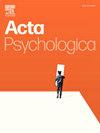Can MMPI-2-RF confirm the structural validity of the somatoform spectrum of the Hierarchical Taxonomy of Psychopathology (HiTOP) in patients with chronic low back pain
IF 2.7
4区 心理学
Q2 PSYCHOLOGY, EXPERIMENTAL
引用次数: 0
Abstract
Objectives
This study aimed to evaluate the structural validity of the somatoform spectrum within the context of the Hierarchical Taxonomy of Psychopathology (HiTOP) model in patients with chronic low back pain.
Methods
233 patients who were diagnosed with chronic low back pain (77.3 % female) completed the Oswestry Disability Index (ODI), the Health Anxiety Inventory-18 (HAI-18), the Minnesota Multiphasic Personality Inventory–2–Restructured Form (MMPI-2-RF), and the Patient Health Questionnaire (PHQ-15). Confirmatory factor analyses were conducted at two levels: spectra and symptom levels. Competing models were tested—one modeling somatoform as an independent spectrum, and the other integrating it under the internalizing spectrum.
Results
The distinct somatoform spectrum model showed superior fit at both the spectra (χ2 = 1.60, df = 12, p = .083) and symptom levels (χ2 = 1.12, df = 118, p = .161), compared to the nested internalizing model, which had weaker fit indices (spectra: χ2 = 2.05, df = 12, p = .016; symptom: χ2 = 1.73, df = 127, p < .001). In the correlation analysis (all p < .01), emotional and internalizing dysfunction was strongly linked to low positive emotions (r = 0.60), dysfunctional negative emotions (r = 59), and negative emotionality/neuroticism (r = 0.60), and moderately to thought dysfunction (r = 0.27); thought dysfunction showed powerful associations with psychoticism (r = 0.94), aberrant experiences (r = 0.84), and ideas of persecution (r = 0.79); behavioral and externalizing dysfunction correlated highly with disconstraint (r = 0.85) and antisocial behavior (r = 0.73); health anxiety was moderately related to negative emotionality/neuroticism (r = 0.21), cynicism (r = 0.22), and dysfunctional negative emotions (r = 26); somatic symptom severity (phq-15) was associated with somatic complaints (r = 0.41), ideas of persecution (r = 0.22), and negative emotionality/neuroticism (r = 0.24); and disability (ODI) correlated with somatic complaints (r = 0.25), ideas of persecution (r = 0.17), and negative emotionality/neuroticism (r = 0.19).
Conclusion
These findings support the structural independence of the somatoform spectrum within the HiTOP framework, especially in medical samples, and encourage further cross-cultural validation.

MMPI-2-RF能否证实慢性腰痛患者精神病理分级分类(HiTOP)躯体形式谱的结构有效性
目的本研究旨在评估慢性腰痛患者在精神病理层次分类(HiTOP)模型下躯体形式谱的结构有效性。方法233例慢性腰痛患者(女性77.3%)完成Oswestry残疾指数(ODI)、健康焦虑量表-18 (HAI-18)、明尼苏达多相人格量表-2-重构表(MMPI-2-RF)和患者健康问卷(PHQ-15)。验证性因子分析在两个水平上进行:谱和症状水平。对相互竞争的模型进行了测试——一个模型将躯体形式建模为一个独立的频谱,另一个模型将其整合到内部化频谱下。结果与嵌套内化模型(χ2 = 2.05, df = 12, p = 0.016; χ2 = 1.12, df = 118, p = 0.161)相比,嵌套内化模型(χ2 = 2.05, df = 12, p = 0.016;χ2 = 1.73, df = 127, p <;措施)。在相关分析中(所有p <;.01),情绪和内化功能障碍与低积极情绪(r = 0.60)、功能失调的消极情绪(r = 59)和消极情绪/神经质(r = 0.60)密切相关,中度与思想功能障碍(r = 0.27)密切相关;思维障碍与精神病(r = 0.94)、异常经历(r = 0.84)和迫害观念(r = 0.79)有很强的相关性;行为和外化功能障碍与约束解除(r = 0.85)和反社会行为(r = 0.73)高度相关;健康焦虑与负性情绪/神经质(r = 0.21)、玩世不恭(r = 0.22)和功能失调负性情绪(r = 26)有中度相关;躯体症状严重程度(phq-15)与躯体抱怨(r = 0.41)、受迫害想法(r = 0.22)和负面情绪/神经质(r = 0.24)相关;残疾(ODI)与躯体抱怨(r = 0.25)、受迫害想法(r = 0.17)和消极情绪/神经质(r = 0.19)相关。这些发现支持了HiTOP框架中躯体形式谱的结构独立性,特别是在医学样本中,并鼓励进一步的跨文化验证。
本文章由计算机程序翻译,如有差异,请以英文原文为准。
求助全文
约1分钟内获得全文
求助全文
来源期刊

Acta Psychologica
PSYCHOLOGY, EXPERIMENTAL-
CiteScore
3.00
自引率
5.60%
发文量
274
审稿时长
36 weeks
期刊介绍:
Acta Psychologica publishes original articles and extended reviews on selected books in any area of experimental psychology. The focus of the Journal is on empirical studies and evaluative review articles that increase the theoretical understanding of human capabilities.
 求助内容:
求助内容: 应助结果提醒方式:
应助结果提醒方式:


